Last-Minute NYC Holiday Gift Guide 🎁
We’ve created a holiday gift guide with presents for the intrepid New Yorker that should arrive just in time—


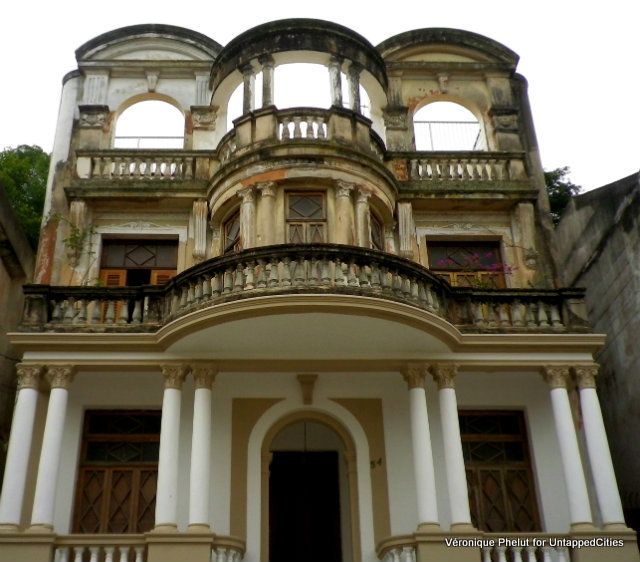
Although the name can be confusing, Santa Teresa is not a Brazilian divinity or a religious figure. Santa, as it is known locally, is a historical neighborhood located on top of a hill and offering some splendid views of the city of Rio de Janeiro, a true escape from the beach. The nicest way to reach it is via Lapa and the famous Selarón stairway, 215 steps decorated with regularly-changing mosaics, created by Chilean artist Jorge Selarón. For over a century, you could use the “bonde elétrico” (tramway) from the Centro, with a ride crossing the Lapa Arches, but the service was suspended in August 2011 for safety reasons after a fatal accident.
Winding, narrow and cobble-stoned streets, aging 19th and 20th century buildings, architectural beauties: you don’t really feel you’re in the heart of Rio de Janeiro. Santa Teresa was built around the monastery of the Carmelites, the Santa Teresa Convent, during the 18th century. By that time, the upper class was living there and they built magnificent mansions inspired by French architecture, some of which still exist. By the 20th century, it became home to artists, who used to appear at the Civic Theatre, and it soon became known as the “Carioca Montmartre”. It is now a symbol of culture and art, a Bohemian way of life, as the countless workshops, studios, galleries and museums testify, along with a rich street art scene.
Santa seems to have stopped in time, keeping aspects of the Old Rio preserved for decades, and having a history to tell on every corner. You won’t find any McDonald’s, traffic lights, gas station; the buildings have no private parking, were never demolished, and some of them are now falling apart. What you will find however are all architectural styles: art déco, eclectic, neo-Gothic, neo-colonial, Normand, etc. Let’s travel through some of the most inspiring mansions.
Mansion on Rua Triunfo 38
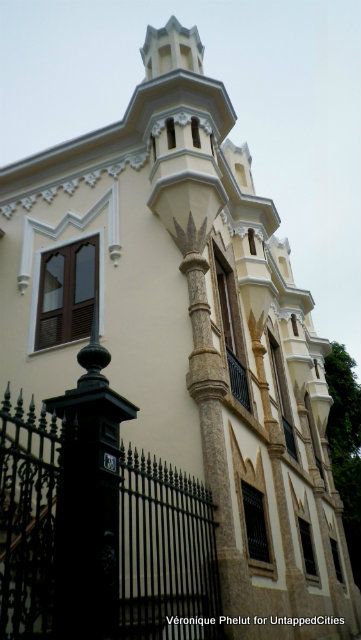
This house is of strong military-medieval inspiration. On top of it loom four small towers that interspersed between the bays of the facade. We can see a frieze sculpted participating of the fanciful decorative facade. Access to the interior is made via a ladder of iron, on the side.
House on Rua Fonseca Guimarães 55
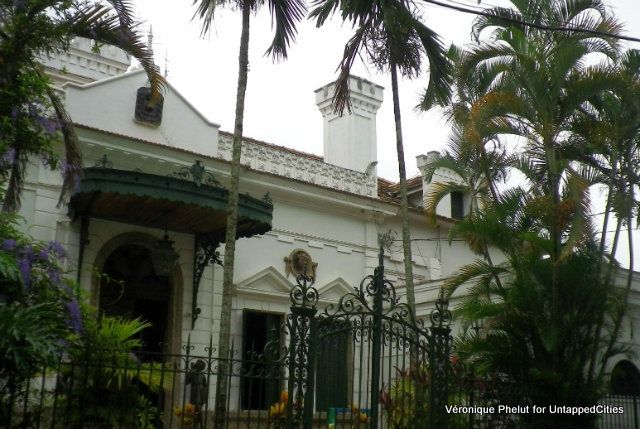
This little castle in Gothic style, with an exceptional architectural quality, was built in 1888. It stands amid a large wooded terrain at the bend of the street. The facade hides a discreet and stylish home. In the background, we can see a tower topped with a thin needle.
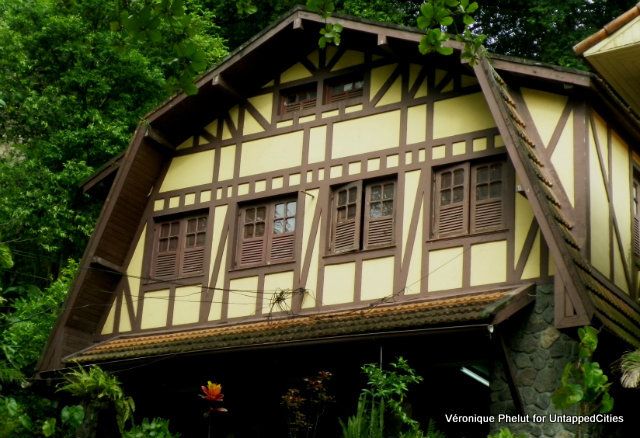
At the end of a street near a workshop stands this Tudor-style mansion, with half-timbering. The wooden structure of the windows and the timber roof-structure are also reminiscent of chalet-type construction.
Rua Aprazível: Chalet
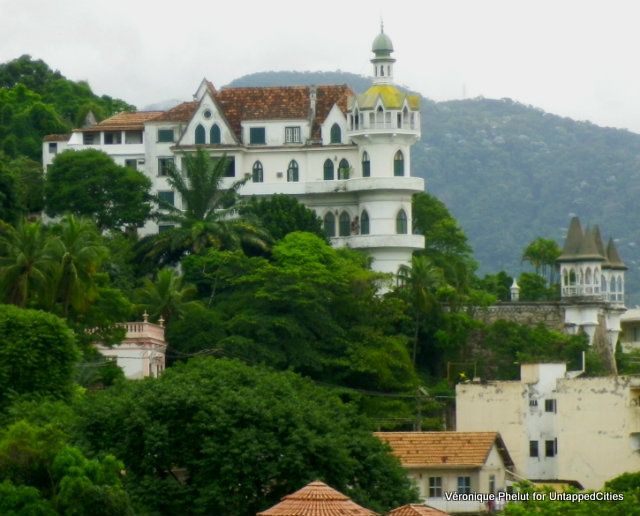
After the mid-nineteenth century, Santa Teresa became more intensely inhabited, just as the fashion of Alpine chalets settled in Rio, fueled by the desire for a simple life away from urban areas and in greater harmony with nature. Santa has several types of chalets: big ones with gable roof and iron-made mantling, and small ones in series, or copies with magnificent wood work, where the breathtaking view inspired the construction of an observatory on the roof.
The Valentim Castle

Built in the late nineteenth century, more precisely in 1879, by Anthony Valentine, the castle is now divided in 8 apartments. Architect Fernando Valentine, the son of the builder, went ahead with the division in the 30s due to the difficulty of maintaining the whole castle.
This castle with its strong medieval inspiration represents the romantic fantasy of the carioca architecture, which reaches one of its highest grades here. The Valentim castle is to be viewed from various angles: underneath, from the left, from a distance. The towers, gazebos, domes and roofs change their relative positions as you pass.
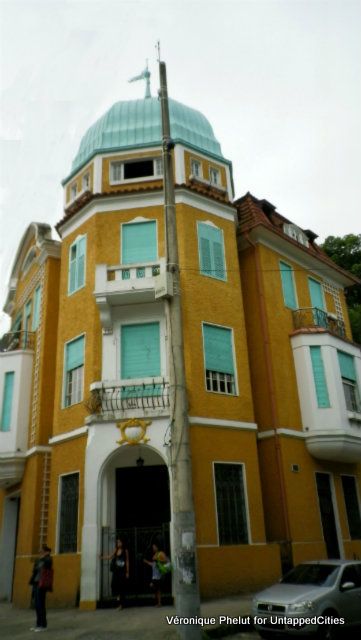
Named by Baron Curvelo, the Portuguese Commander Joaquim José de Meirelles Freire, who resided nearby. There stands a high house with triangular bay windows, the German style of which is characterized mainly by the shape of the dome.
Mansion Abigail Seabra de Paula Buarque
Just by the Largo do Curvelo on Rua Almirante Alexandrino 5 stands this house, inspired by the deck of a boat, which is why it’s also called also called “Casa Navio” – The Ship House. Built by architect Paulo Autunes Ribeiro in 1938, it explore in its composition symmetry and articulation of pure volumes. Cylindrical and cubic forms are juxtaposed, causing swings and edges. This line of Art Deco, drier and closer to the recent rationalism, takes advantage of the position at the street corner to overcome the inconveniences of the ground (small and uphill); the building thus creates interesting aesthetics thanks to the flat and curved surfaces, alternating as you walk around the property.
Mansion Joaquim da Costa Vieira Mendes
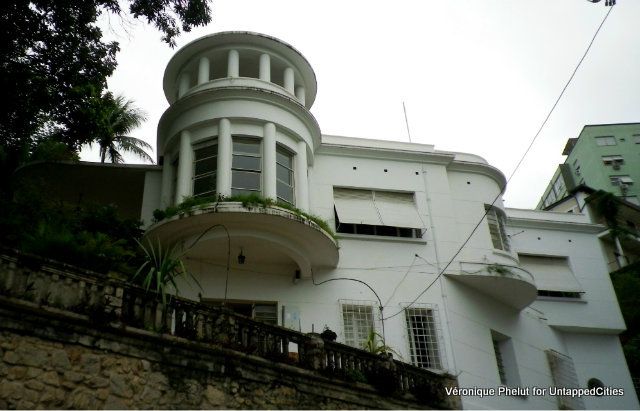
The irregular shape and the steep slopes of the site imposed difficulties to an unknown architect when building this residence on Rua Santa Cristina 107 in the 1930s. Downstairs, the building follows the limits of the building alignment. The second floor, however, reveals more geometric resourcefulness. A curiosity is the gazebo-shaped Greek revival pavilion.
Architectural beauties to discover are countless in Santa Teresa. You can spend a whole day strolling around, getting safely lost and enjoy Santa’s highlights. Don’t miss some great museums, like the Chacára do Céu, the Benjamin Constant Museum and the Laurinda Santos Lobo CC. Apart from telling Santa’s history through art and culture (great collections of modern art and history of the ‘bonde’), they are also worth to see as architectural gems.
Subscribe to our newsletter